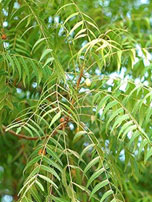SHAHEED KARTAR SINGH SARABHA AYURVEDIC MEDICAL COLLEGE & HOSPITAL
Affiliated to Guru Ravidas Ayurved University, Hoshiarpur Punjab
Affiliated to Guru Ravidas Ayurved University, Hoshiarpur Punjab

Botanical Name : Azadirachta indica A. Juss.
Family : Meliaceae
Introduction :
This plant very useful in skin disease. it used as biological pesticide. Seed oil using for hair fall.
Names in different Indian languages :
English : Neem tree,Margosa tree,Indian lilac
Hindi : nim
Kannada : Turakabevu,huccabevu,cikkabevu
Malayalam : Veppu,aryaveppu,kaippanveppu
Sanskrit : Nimbah,prabhadrah
Tamil : Vempu,veppu,Arulundi
Telugu : Kindavepu,turakavepu
Unani : Aazaad
Synonyms :
Arita, Picumarda, Picumanda, Sarvatobhadra, Hinguniryasa, Yavanesta,Sukapriya, Netã, Subhadra, Prabhadra, Sutiktã, Nimba, Nimbaka,Arishtaphala, Pichumarda, Pichumanda, Pichumandaka, Tiktaka, Paaribhadra.
Melia azadirachta Linn
Varieties & adulterants – (CV – controversy, AD – adulterants) :
1.Nimba = Azadirachta indica
2. Mahã Nimba = Ailanthus exelsa.
Morphology :
It is a large tree growing up to 20-25 m. high
Leaves- imparipinnate, crowded at the ends, of branches; leaflets 9-17, opposite, sub opposite; lanceolate, acuminate, serrate or dentate, glabrous.
Flowers-numerous, white, honey-scented.
Fruits- 1- seeded drupes, oblong, yellow when ripe.
Seeds contain oil. (Flowers in February-April and fruits during June-August)
Distribution & Habitat :
Commonly found in various parts of India.
Chemical constituents :
Leaves— Azadirachtin, azadirachtanin, azadirone, nimbandiol, nimbin, nimbolide etc.
Stem bark— nimbin, nimbidin, nimbinin, sitosterol, kulinone, margosinolide etc.
Root bark—nimbin, nimbidin.
Fruits—Azadirachtin, azadirachtol, azadirachnol, melianone, nimbiol, nimocin etc.
Seed oil—Tocopherol, azadirone, azadiradione, nimbinin, salannol, nimbin, nimbidin etc.
Flowers—Azadiradione, margosene, linoleic acid, arachidic acid etc.
Properties :
Rasa: Tikta, Kasaya
Guna: Laghu, Rüksa
Virya : Sita
Vipäka : Katu
Karma : Kapha-pittahara, Dipana, Grãhi, Krmighna, Netrya
Leaf, bark—antimicrobial, antifungal, anthelmintic, insecticidal, antiviral, antipyretic, antimalarial, antiperiodic, mosquito larvicidal, anti-inflammatory, antifertility, spermicidal, hypoglycaemic;
Oil—used
Internal uses :
Digestive system By its astringent and bitter property it improves taste and is constipative.
Fruit is purgative.
Leaves are stimulant of liver. Its bark decoction with honey is useful In jaundice, anorexia, vomiting, dysentery, intestinal worms, liver diseases. Ointment prepared from seeds is applied in piles.
Respiratory system : Its property of tikta reduces the kapha from respiratory passage. Leaves are more useful in excessive mucous secretion, Bark decoction is used in chronic cough. 30- 60 cc of liquid collected from the trunk is given in TB.
Urinary system : It is effective in diabetes.
Reproductive system : its seed uterine stimulant. Seed powder is used in dysmenorrheal. Continuous use of leaves leads to a decrease in the shukra dhatus. it is a uterine Ionic. Since it is excreted in human milk, it is useful in preventing cough and skin diseases in infants.
Skin : It is useful in all skin conditions specially in burning sensation.
Satmikaran : In general debility, young leaves and gum is useful. The concept behind chewing nimbo leaves on Marathi is to prevent kapha disease. watery discharge from nimba is useful in emaciation and TB. Nimba is best rasayan in medo -roga (fat disorders)
Temperature : Antipyretic. useful in chronic kapha jwara. malarial fever & fever.
Eyes : Tender leaves anti flowers are useful in many skin disorders,
